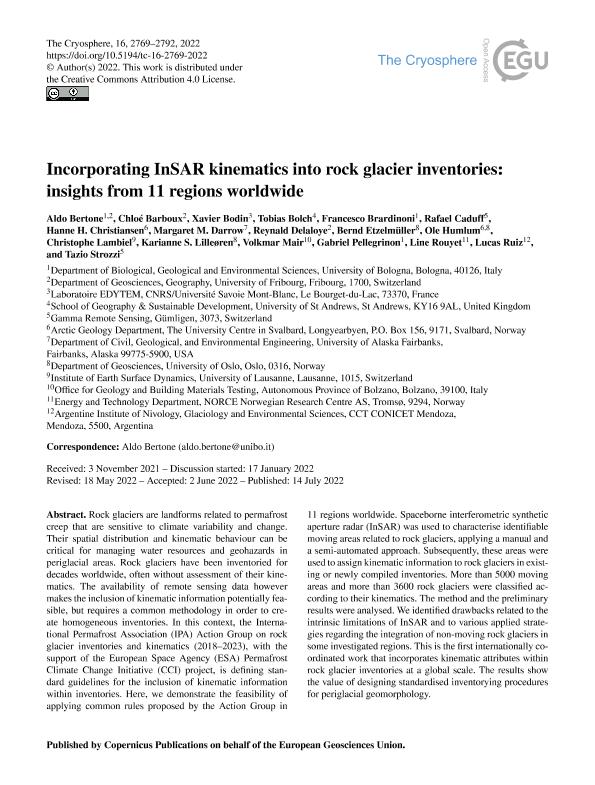Mostrar el registro sencillo del ítem
dc.contributor.author
Bertone, Aldo
dc.contributor.author
Barboux, Chloé
dc.contributor.author
Bodin, Xavier
dc.contributor.author
Bolch, Tobias
dc.contributor.author
Brardinoni, Francesco
dc.contributor.author
Caduff, Rafael
dc.contributor.author
Christiansen, Hanne H.
dc.contributor.author
Darrow, Margaret M.
dc.contributor.author
Delaloye, Reynald
dc.contributor.author
Etzelmüller, Bernd
dc.contributor.author
Humlum, Ole
dc.contributor.author
Lambiel, Christophe
dc.contributor.author
Lilleøren, Karianne S.
dc.contributor.author
Mair, Volkmar
dc.contributor.author
Pellegrinon, Gabriel
dc.contributor.author
Rouyet, Line
dc.contributor.author
Ruiz, Lucas Ernesto

dc.contributor.author
Strozzi, Tazio
dc.date.available
2023-07-12T13:19:40Z
dc.date.issued
2022-07
dc.identifier.citation
Bertone, Aldo; Barboux, Chloé; Bodin, Xavier; Bolch, Tobias; Brardinoni, Francesco; et al.; Incorporating InSAR kinematics into rock glacier inventories: insights from 11 regions worldwide; Copernicus Publications; Cryosphere; 16; 7; 7-2022; 2769-2792
dc.identifier.issn
1994-0424
dc.identifier.uri
http://hdl.handle.net/11336/203414
dc.description.abstract
Rock glaciers are landforms related to permafrost creep that are sensitive to climate variability and change. Their spatial distribution and kinematic behaviour can be critical for managing water resources and geohazards in periglacial areas. Rock glaciers have been inventoried for decades worldwide, often without assessment of their kinematics. The availability of remote sensing data however makes the inclusion of kinematic information potentially feasible, but requires a common methodology in order to create homogeneous inventories. In this context, the International Permafrost Association (IPA) Action Group on rock glacier inventories and kinematics (2018-2023), with the support of the European Space Agency (ESA) Permafrost Climate Change Initiative (CCI) project, is defining standard guidelines for the inclusion of kinematic information within inventories. Here, we demonstrate the feasibility of applying common rules proposed by the Action Group in 11 regions worldwide. Spaceborne interferometric synthetic aperture radar (InSAR) was used to characterise identifiable moving areas related to rock glaciers, applying a manual and a semi-automated approach. Subsequently, these areas were used to assign kinematic information to rock glaciers in existing or newly compiled inventories. More than 5000 moving areas and more than 3600 rock glaciers were classified according to their kinematics. The method and the preliminary results were analysed. We identified drawbacks related to the intrinsic limitations of InSAR and to various applied strategies regarding the integration of non-moving rock glaciers in some investigated regions. This is the first internationally coordinated work that incorporates kinematic attributes within rock glacier inventories at a global scale. The results show the value of designing standardised inventorying procedures for periglacial geomorphology. Copyright:
dc.format
application/pdf
dc.language.iso
eng
dc.publisher
Copernicus Publications

dc.rights
info:eu-repo/semantics/openAccess
dc.rights.uri
https://creativecommons.org/licenses/by/2.5/ar/
dc.subject
ROCK GLACIER
dc.subject
SAR
dc.subject
KINEMATIC INFORMATION
dc.subject
PERMAFROST
dc.subject.classification
Geografía Física

dc.subject.classification
Ciencias de la Tierra y relacionadas con el Medio Ambiente

dc.subject.classification
CIENCIAS NATURALES Y EXACTAS

dc.title
Incorporating InSAR kinematics into rock glacier inventories: insights from 11 regions worldwide
dc.type
info:eu-repo/semantics/article
dc.type
info:ar-repo/semantics/artículo
dc.type
info:eu-repo/semantics/publishedVersion
dc.date.updated
2023-07-05T15:26:49Z
dc.journal.volume
16
dc.journal.number
7
dc.journal.pagination
2769-2792
dc.journal.pais
Austria

dc.description.fil
Fil: Bertone, Aldo. Universidad de Bologna; Italia. Universite de Fribourg;
dc.description.fil
Fil: Barboux, Chloé. Universite de Fribourg;
dc.description.fil
Fil: Bodin, Xavier. Université Savoie Mont Blanc; Francia
dc.description.fil
Fil: Bolch, Tobias. University of St. Andrews; Reino Unido
dc.description.fil
Fil: Brardinoni, Francesco. Universidad de Bologna; Italia
dc.description.fil
Fil: Caduff, Rafael. Gamma Remote Sensing; Suiza
dc.description.fil
Fil: Christiansen, Hanne H.. The University Centre in Svalbard; Noruega
dc.description.fil
Fil: Darrow, Margaret M.. University of Alaska; Estados Unidos
dc.description.fil
Fil: Delaloye, Reynald. Universite de Fribourg;
dc.description.fil
Fil: Etzelmüller, Bernd. University of Oslo; Noruega
dc.description.fil
Fil: Humlum, Ole. University of Oslo; Noruega. The University Centre in Svalbard; Noruega
dc.description.fil
Fil: Lambiel, Christophe. Universite de Lausanne; Suiza
dc.description.fil
Fil: Lilleøren, Karianne S.. University of Oslo; Noruega
dc.description.fil
Fil: Mair, Volkmar. Office For Geology And Building Materials Testing; Italia
dc.description.fil
Fil: Pellegrinon, Gabriel. Universidad de Bologna; Italia
dc.description.fil
Fil: Rouyet, Line. Norce Norwegian Research Centre; Noruega
dc.description.fil
Fil: Ruiz, Lucas Ernesto. Consejo Nacional de Investigaciones Científicas y Técnicas. Centro Científico Tecnológico Conicet - Mendoza. Instituto Argentino de Nivología, Glaciología y Ciencias Ambientales. Provincia de Mendoza. Instituto Argentino de Nivología, Glaciología y Ciencias Ambientales. Universidad Nacional de Cuyo. Instituto Argentino de Nivología, Glaciología y Ciencias Ambientales; Argentina
dc.description.fil
Fil: Strozzi, Tazio. Gamma Remote Sensing; Suiza
dc.journal.title
Cryosphere
dc.relation.alternativeid
info:eu-repo/semantics/altIdentifier/url/https://tc.copernicus.org/articles/16/2769/2022/
dc.relation.alternativeid
info:eu-repo/semantics/altIdentifier/doi/http://dx.doi.org/10.5194/tc-16-2769-2022
Archivos asociados
